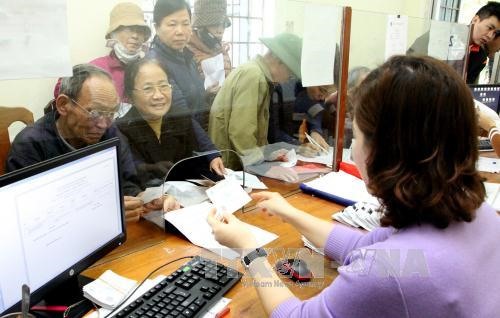 Society
Society

The Việt Nam Social Insurance Agency will prioritise the development of e-transaction systems to help control costs and prevent abuse of the social insurance fund this year, officials have said.
 |
| A staff from Vietnam Social Insurance Agency branch in Nghệ An Province is delivering social insurance cards for local people. — Photo baotintuc.vn |
HÀ NỘI — The Việt Nam Social Insurance Agency will prioritise the development of e-transaction systems to help control costs and prevent abuse of the social insurance fund this year, officials have said.
Speaking at an online discussion on the management of the social insurance fund on Saturday, the Agency’s Deputy Director General Phạm Lương Sơn said the body had created a database of insurance buyers and an information system to assess health insurance, contributing to better control over medical costs.
“Thus, the development of e-transaction systems is a priority solution to help the sector develop further in 2017,” said Sơn.
“The agency has strictly followed the National Assembly’s directive to apply information technology and improve administrative reform, facilitating people and enterprises to participate into the social, health, and unemployment insurance system.”
Sơn refuted reports by some newspapers that had cited the State Audit Office of Việt Nam in claiming that the agency’s 2015 management costs were 75.8 per cent higher than that of the previous year.
“The management cost was approved by the Government through strict and cautious processes,” he said.
In line with Decision No 153/QD-TTg, dated January 28, 2015, then Prime Minister Nguyễn Tấn Dũng had allocated a management spending package of VNĐ6.56 trillion (US$288 million) to the Việt Nam Social Insurance Agency in 2015, an increase of 59 per cent compared with 2014. The increased funds were intended to help carry out certain essential urgent tasks, which were impossible to undertake in previous years due to a lack of finance. These tasks include managing communications to expand the number of buyers of social, medical and unemployment insurance; ensuring administrative reform; and adopting e-transactions.
The year 2015 witnessed a rise in the number of buyers of social, medical and unemployment insurance. Total management expenditure for 2015 rose by 6 per cent year-on-year, which was mainly due to the raised basic salary paid to nearly 22,000 employees across the whole system.
In response to rumours that the income and expenses of social, medical and unemployment insurance were imbalanced in recent years, Sơn said expenditure in 2015 was lower than income from these types of insurance.
“The Medical Insurance Fund had to make a huge investment in technological development to increase the number of insurance buyers in 2015, but the difference remained VNĐ5 trillion ($219 million),” said Sơn.
Expenditure from the unemployment insurance fund accounted for only 50.3 per cent of total income, allowing the Ministry of Labour, Invalids and Social Affairs to propose the National Assembly should lower the unemployment insurance premiums paid by labourers, Sơn added.
“It is necessary to apply information technology and to properly connect social and health insurance buyers with medical facilities and the social insurance system nationwide to ensure sustainable and transparent development,” said Deputy Chairman of the National Assembly’s Social Affairs Committee Bùi Sỹ Lợi.
In 2016, the social insurance agency stayed focused on improving communications to increase the number of buyers and improve applications of information technology.
“Increased costs for better management is necessary,” said Lợi.
“Further, the increased number of insurance buyers requires additional funds, provided they are not misused.”
Lợi said the social insurance agency’s management costs were restricted to 2.3 per cent of the total income, and expenses were covered by the growth investment fund, not the social insurance fund.
He added that a report by the State Audit Office of Việt Nam indicated that Việt Nam’s social insurance agency’s management costs had strictly aligned with the State’s principles.
Lợi said the NA Standing Committee had always strictly supervised issues related to the social insurance agency’s management costs, allowing no increases in the number of personnel but ensuring improvements in working conditions and quality to retain transparency and earn people’s trust.
“Management expenditure must be carefully calculated as it comes from labourers’ money. Any spending must be based on specific objectives for the development of social and medical insurance policies,” Lợi said.
Retirement age
During the discussion, Lợi said the adjustment of the retirement age was not an optimal solution to ensure the sustainability of the social insurance fund.
“But it is necessary to discuss it as the time has come to consider raising the retirement age to enable labourers to prepare for the future,” Lợi said.
“It is significant that processes and steps to gradually increase the pension age of certain groups are being considered and discussions opened to seek public opinions.”
Sơn from the social insurance agency said the move would ensure the interrelation between insurance premium payments and payouts and deal with the shortage of labour due to the decline in the working-age population.
“This is one of the solutions for ensuring the long-term sustainability of the pension schemes. Raising the retirement age has nothing to do with the management costs of the social insurance agency,” Sơn said. — VNS




